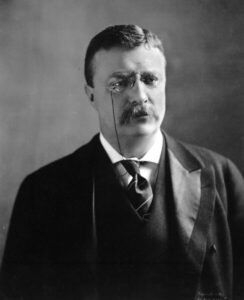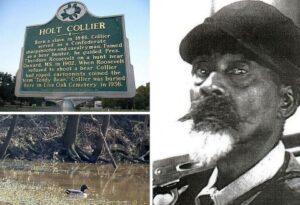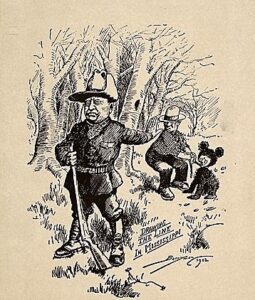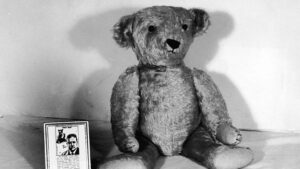 Most people may be aware that the “teddy bear” has some relation to President Theodore Roosevelt. However, the embedded lessons that can be learned can be seen as lessons from the Pilgrims in 1620 who planted a church in covenant with Christ and one another. They were willing to endure hardship, “whatsoever it should cost them.” Their conscience was a self-restraint or moral compass. Bradford wrote that their purpose was “to advance the gospel of the kingdom of Christ in those remote parts of the world, yea, though they would be as stepping stones unto others for the performance of so great a work.” The Christian self-government of the individual has always been the cornerstone of the Kingdom of God and a part of our national fabric.
Most people may be aware that the “teddy bear” has some relation to President Theodore Roosevelt. However, the embedded lessons that can be learned can be seen as lessons from the Pilgrims in 1620 who planted a church in covenant with Christ and one another. They were willing to endure hardship, “whatsoever it should cost them.” Their conscience was a self-restraint or moral compass. Bradford wrote that their purpose was “to advance the gospel of the kingdom of Christ in those remote parts of the world, yea, though they would be as stepping stones unto others for the performance of so great a work.” The Christian self-government of the individual has always been the cornerstone of the Kingdom of God and a part of our national fabric.
 So what does this have to do with the teddy bear? On November 13, 1902, a 56-year-old former slave, Holt Collier, led a hunting party with President Roosevelt. Collier was a Confederate Cavalry sharp-shooter during the Civil War, and was such an amazing hunter that he probably killed more bears in his lifetime than Daniel Boone or Davy Crockett! Roosevelt would end up hunting with him again in 1907, and called him “the greatest hunter and guide I have ever known.” Due to the popularity of President Roosevelt as a hunter, this 1902 trip was nationally known in the newspapers of the time.
So what does this have to do with the teddy bear? On November 13, 1902, a 56-year-old former slave, Holt Collier, led a hunting party with President Roosevelt. Collier was a Confederate Cavalry sharp-shooter during the Civil War, and was such an amazing hunter that he probably killed more bears in his lifetime than Daniel Boone or Davy Crockett! Roosevelt would end up hunting with him again in 1907, and called him “the greatest hunter and guide I have ever known.” Due to the popularity of President Roosevelt as a hunter, this 1902 trip was nationally known in the newspapers of the time.
Theodore Roosevelt had already become famous for his courageous leadership in the decisive battle of San Juan Hill during the Spanish-American War in 1898. Roosevelt was a “hard hunter,” chasing down big game such as bear, bison, caribou, cougar, and moose. Concerned about the reckless slaughter of wildlife, he helped start the Boone and Crockett Club. Initially only 100 were members, each having to have caught three of the big game above. He then became the club’s first president. An ethical standard of self-restraint became known as “fair chase.” Denny Quaiff writes:
“Fair chase is a term used by hunters to describe an ethical approach to hunting big game animals. North America’s oldest wildlife conservation group, the Boone and Crockett Club, defines ‘fair chase’ as requiring hunted big game animals to be wild and free-ranging. ‘Wild’ refers to an animal that is naturally bred and lives in nature. ‘Free-ranging’ means an animal that is not confined by artificial barriers.”
 President Roosevelt is known to have said, “Conservation means development as much as it does protection. I recognize the right and duty of this generation to develop and use the natural resources of our land; but I do not recognize the right to waste them, or to rob, by wasteful use, the generations that come after us.”
President Roosevelt is known to have said, “Conservation means development as much as it does protection. I recognize the right and duty of this generation to develop and use the natural resources of our land; but I do not recognize the right to waste them, or to rob, by wasteful use, the generations that come after us.”
The Boone and Crockett Club adopted an “Entry Affidavit for all Hunter-Taken Trophies,” now updated in the modern era, to “determine if any of the methods listed below were used to harvest the animal, which would make the entry ineligible.” Excerpts include restraining from:
I. Spotting or herding game from the air, followed by landing in its vicinity for the purpose of pursuit and shooting;
II. Herding or chasing with the aid of any motorized equipment…
III. Use of electronic communication devices… drones/unmanned aerial vehicles (UAVs)… devices that transmit images and other information to the hunter;
IV. Confined by artificial barriers, including escape-proof fenced enclosures;
V. Transplanted for the purpose of commercial shooting;
VI. By the use of traps or pharmaceuticals;
VII. While swimming, helpless in deep snow, or helpless in any other natural or artificial medium;
VIII. On another hunter’s license;
IX. Not in full compliance with the game laws or regulations of the federal government or of any state, province, territory, or tribal council on reservations or tribal lands.
 Why are general Fair Chase ethics so important regardless of whether you hunt competitively? It is an internal standard of conscience, an act of self-government. The care of the creation rests on the instructions of the Creator from the book of Genesis, who gave men and women the responsibility of stewarding its resources, but not abusing them. As our society moves further and further away from such ethics, we return to chaos and lawlessness, and stewardship wanes. What we will do to animals, we can excuse with humans as well. Governments cannot successfully protect liberty when individual stewardship is no longer practiced, for it will require them to utilize excessive regulations.
Why are general Fair Chase ethics so important regardless of whether you hunt competitively? It is an internal standard of conscience, an act of self-government. The care of the creation rests on the instructions of the Creator from the book of Genesis, who gave men and women the responsibility of stewarding its resources, but not abusing them. As our society moves further and further away from such ethics, we return to chaos and lawlessness, and stewardship wanes. What we will do to animals, we can excuse with humans as well. Governments cannot successfully protect liberty when individual stewardship is no longer practiced, for it will require them to utilize excessive regulations.
 Cartoonist Clifford Berryman illustrated President Roosevelt’s refusal to kill a trapped bear. The President had gone to settle a border dispute between Mississippi and Louisiana, but he also wanted to hunt. On November 14, 1902, the hunting team asked the President to remain in his cabin until the hounds had cornered a bear, for he had not caught one yet. Roosevelt was not pleased, for he believed “the tougher the hunt, the better.” The Boone-Crockett Club reports, “Once the guides and hounds had exhausted a small bear after a long chase, the other hunters tied a rope around the bear’s front end, dragged him out of the mud hole he was using to escape the dogs, tied him to a tree, and sent for the President.” President “Teddy” Roosevelt flatly refused to kill the helpless bear, for it violated fair chase ethics.
Cartoonist Clifford Berryman illustrated President Roosevelt’s refusal to kill a trapped bear. The President had gone to settle a border dispute between Mississippi and Louisiana, but he also wanted to hunt. On November 14, 1902, the hunting team asked the President to remain in his cabin until the hounds had cornered a bear, for he had not caught one yet. Roosevelt was not pleased, for he believed “the tougher the hunt, the better.” The Boone-Crockett Club reports, “Once the guides and hounds had exhausted a small bear after a long chase, the other hunters tied a rope around the bear’s front end, dragged him out of the mud hole he was using to escape the dogs, tied him to a tree, and sent for the President.” President “Teddy” Roosevelt flatly refused to kill the helpless bear, for it violated fair chase ethics.
 The cartoon read “drawing the line in Mississippi.” In essence, this was the real “border” dispute Roosevelt made famous! It clarified a line of ethical behavior when it came to hunting. The cartoon caught the attention of Morris and Rose Michtom from Brooklyn, who made stuffed animals. They made two stuffed bears for display in their shop window in early 1903. With President Roosevelt’s permission, they called them “teddy bears.” So now, when your children or grandchildren cuddle a teddy bear, let them know that the training of their conscience and self-restraint is at the heart of this simple blessing. We need to train our children’s consciences, so that the multi-million-dollar sensation of the stuffed “teddy bear” can help us restore our ethics of right and wrong!
The cartoon read “drawing the line in Mississippi.” In essence, this was the real “border” dispute Roosevelt made famous! It clarified a line of ethical behavior when it came to hunting. The cartoon caught the attention of Morris and Rose Michtom from Brooklyn, who made stuffed animals. They made two stuffed bears for display in their shop window in early 1903. With President Roosevelt’s permission, they called them “teddy bears.” So now, when your children or grandchildren cuddle a teddy bear, let them know that the training of their conscience and self-restraint is at the heart of this simple blessing. We need to train our children’s consciences, so that the multi-million-dollar sensation of the stuffed “teddy bear” can help us restore our ethics of right and wrong!







